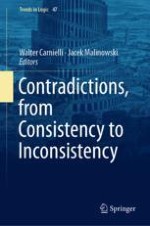2018 | OriginalPaper | Chapter
Keeping Globally Inconsistent Scientific Theories Locally Consistent
Authors : Michèle Friend, Maria del Rosario Martínez-Ordaz
Published in: Contradictions, from Consistency to Inconsistency
Publisher: Springer International Publishing
Activate our intelligent search to find suitable subject content or patents.
Select sections of text to find matching patents with Artificial Intelligence. powered by
Select sections of text to find additional relevant content using AI-assisted search. powered by
